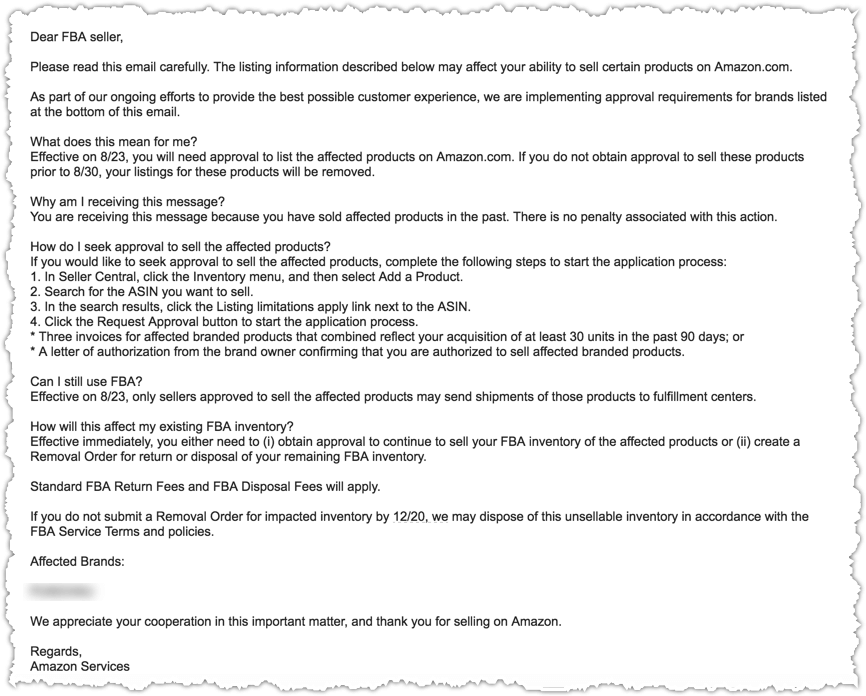Blog: The New Policy To End Amazon Listing Hijackers: Important Update
The New Policy To End Amazon Listing Hijackers: Important Update
If you are an Amazon seller, you may have received an email with the foreboding subject line, “Important Information about your Seller Account”. However, the policy updates will actually be favorable for sellers. In short, Amazon will require approval to sell some private label brands. Sellers need to seek approval by August 30th, 2016. If you do not obtain approval before 8/30, the listings for these products will be removed. OK, sounds serious, I’m not going to call that bluff…
This is what the email looks like:

Why is Amazon starting this new policy, with such a short turnaround time? My hypothesis is that they are addressing the growing problem of listing hijackers and counterfit items on Amazon. I wrote about the Amazon’s listing hijackers in this post, which is a helpful read to see what a pesky and troublesome problem they can be
Here are the exact steps that Amazon sent out for how to seek approval for the affected products
1. In Seller Central, click the Inventory menu, and then select Add a Product.
2. Search for the ASIN you want to sell.
3. In the search results, click the Listing limitations apply link next to the ASIN.
4. Click the Request Approval button to start the application process.
* Three invoices for affected branded products that combined reflect your acquisition of at least 30 units in the past 90 days; or
* A letter of authorization from the brand owner confirming that you are authorized to sell affected branded products.
I think that this will encourage private label sellers to go through the Amazon Brand Registry program to register their brands in order to gain approval.
A Note On The Amazon Brand Registry
The Amazon Brand Registry is a helpful way for private label sellers who manufacture and sell their own products. By registering your private label brand with the Amazon Brand Registry, you are officially noting with Amazon that you are the brand owner. This makes it easier for private label sellers and brand owners to list their own products on Amazon, and protect their listing against listing hijackers who would attempt to sell a counterfeit or second
There are additional benefits to the Amazon Brand Registry, which is noted as the following by Amazon:
Influence the product detail information for your branded products: As the registered brand owner, you will have increased influence in editing the information on product detail pages for your registered branded products, which then helps you to specify the correct titles, details, images, and other attributes for your branded products.
List products without standard product IDs: Registering your brand enables you to specify an alternative key attribute that you can use to list your branded products instead of a standard product ID (UPC or EAN).
I set up my brand registry in about two minutes. It is super simple, it can be done in two quick steps, assuming you have a landing page set up for your product. If you don’t have that, fear not, it is much easier than it sounds. I would recommend purchasing a cheap domain on GoDaddy, and directing it to a free WordPress.com theme. It doesn’t take any technical skills to set up your website, just following the instructions carefully.
Step 1: Complete The Amazon Brand Registry Application
Calling it an “application” sounds more intimidating than it is. This is Step 1 of 2:

And this is Step 2 of 2:

After completing the two pages, you get this notification of completion!

Why Is This Policy Change Important?
This policy change is important because it restricts how people can sell a private label brand. It is now not so easy for anyone to sell just any product, which means that you will have to have registered a brand in order to sell the brand. I am not completely sure at this point whether this will effect only major brands, or any private label brand. I will certainly update this as it becomes more clear (Amazon's policies are never crystal clear right away). Moreover, I am not positive yet whether this application is necessary only for brands which have gone through the Amazon Brand Registry.
I think what is clear though is that many sellers will get their brands registered. And with a process that is so simple, as noted above, why not?! This is a good step to take in order to protect your brand against hijackers, so that the whole problem of listing hijackers will be a thing of the past.
One interesting ripple effect will be on people who do retail arbitrage–buying products at a steep discount and reselling them for a profit on Amazon. This new policy change may not effect some of the large Retail Arbitrage sellers, however, the smaller sellers may have to make significant changes to their business. This means maybe shifting towards private label sales.
In Conclusion
There is still a lot that remains murky on the details. The most important actionable takeaways from this policy update are twofold:
- If you're selling other brands, apply for approval as soon as possible
- Register your brand ASAP
These are simple steps to take, and could prevent major headaches in the future. In an ecommerce environment that is getting more competitive, and which relies on brand differentiation and customer loyalty, I think that this just forces our hand to do what should have been done already.
If you have any different interpretation of this policy update, or have received direct feedback from Amazon's Seller Support, please share your thoughts with the community in the comments section below! Likewise, I will share any updates that I receive as soon as possible.
